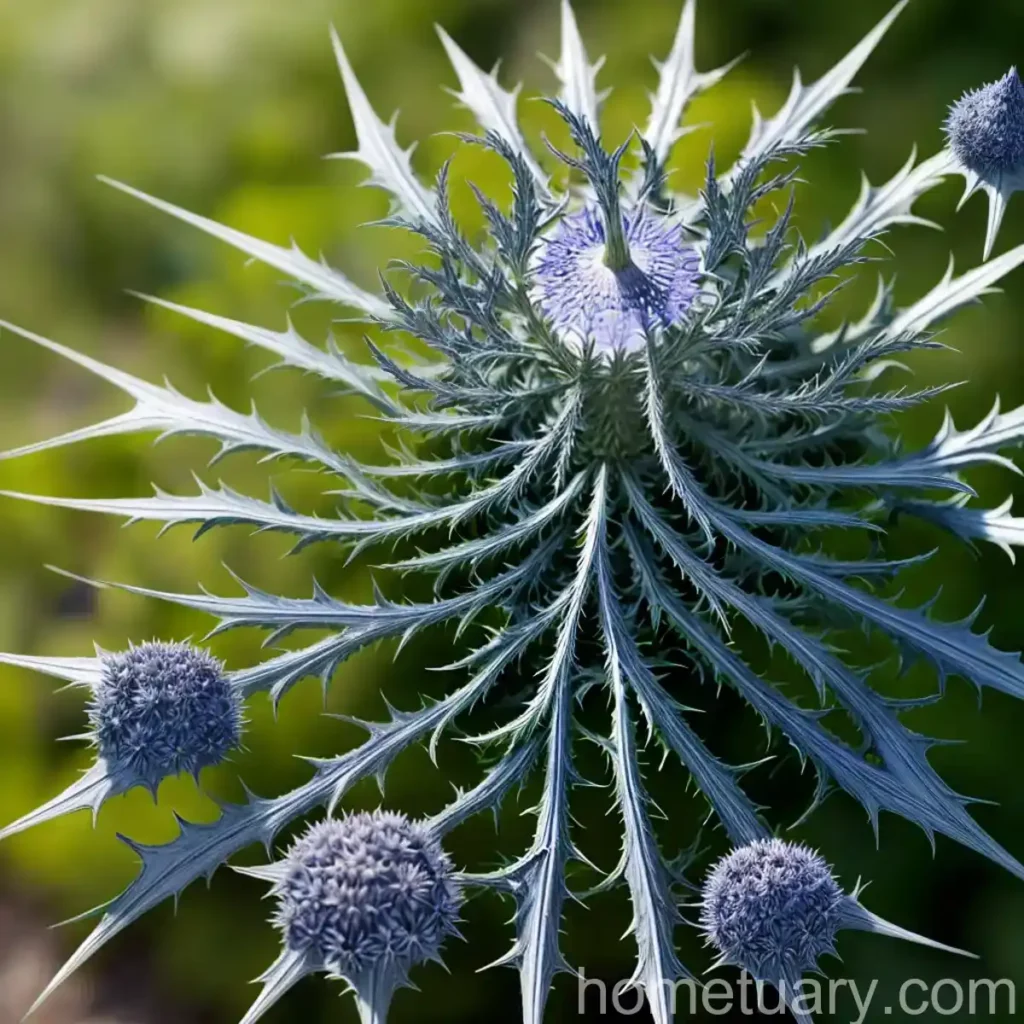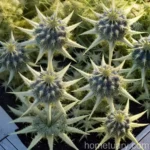The Fascinating World of Variable-Leaved Sea Holly (Eryngium variifolium)
Plants have long captivated human interest with their diverse colors, shapes, and properties. Each plant species has its own unique characteristics and requirements for growth and care. The variable-leaved sea holly, scientifically known as Eryngium variifolium, is a particularly captivating plant that has been admired for its ornamental features and medicinal properties. In this comprehensive guide, we will take an in-depth look at this intriguing plant and explore its uses, cultivation, and care.
What is Variable-Leaved Sea Holly (Eryngium variifolium)?
Eryngium variifolium, commonly known as variable-leaved sea holly, is a species of flowering plant in the family Apiaceae. This perennial herbaceous plant is native to certain regions of South America, where it is found in grasslands and open areas. It is known for its striking appearance, with spiny, blue-green leaves and cone-shaped flower heads surrounded by thistle-like bracts.
The plant’s unique foliage and flowers make it a popular choice for ornamental gardening, and it has also been traditionally used for its medicinal properties. The variable-leaved sea holly has a rich history, folklore, and symbolism, adding to its allure and intrigue.
In the following sections, we will delve into the key aspects of caring for and cultivating Eryngium variifolium, providing valuable insights for plant enthusiasts, gardeners, and botany enthusiasts.
Key Takeaways – Variable-Leaved Sea Holly (Eryngium variifolium)
Culture
Eryngium variifolium thrives in well-drained soil and prefers full sun exposure. It is a drought-tolerant plant that can withstand dry conditions, making it an excellent choice for xeriscaping and water-wise gardening. The plant’s unique foliage and flowers make it a standout feature in garden beds, borders, and rock gardens. It is also an attractive option for cut flower arrangements, adding an exotic and textural element to floral displays.
Uses
In addition to its ornamental value, Eryngium variifolium has been traditionally used for its medicinal properties. The roots and leaves of the plant are known for their diuretic and anti-inflammatory properties, and they have been used in herbal medicine to treat various ailments. Additionally, the striking appearance of the plant makes it a sought-after option for floral arrangements and landscaping, adding a touch of drama and elegance to garden designs.
Water
Eryngium variifolium is well-adapted to dry conditions and has low to moderate water requirements once established. It is important to allow the soil to dry out between watering, as the plant is sensitive to waterlogged conditions. When watering, it is best to provide deep, infrequent irrigation to encourage the development of a robust and deep root system.
Sunlight
This plant thrives in full sun exposure and is tolerant of hot and dry conditions. A minimum of 6-8 hours of direct sunlight is recommended for optimal growth and flowering. In regions with intense heat, providing partial shade during the hottest part of the day can help protect the plant from excessive stress.
Fertilizer
Eryngium variifolium has modest fertilizer needs and can thrive in nutrient-poor soils. A balanced, slow-release fertilizer applied at the beginning of the growing season can support healthy growth and flowering. It is important to avoid excessive fertilization, as this can lead to lush foliage at the expense of flower production.
Soil
Well-drained, sandy or loamy soil with a slightly acidic to neutral pH is ideal for Eryngium variifolium. The plant does not tolerate waterlogging and is prone to root rot in poorly drained soils. Amending heavy clay soils with organic matter can improve drainage and create a more favorable growing environment for the plant.
Pruning
Pruning Eryngium variifolium is primarily focused on deadheading spent flowers to prolong the blooming period and prevent self-seeding. In late winter or early spring, the plant can be cut back to ground level to promote new growth and maintain a tidy appearance. It is important to wear gloves when handling the plant, as the spiny leaves can cause skin irritation.
Propagation
The variable-leaved sea holly can be propagated from seed or through division. Sowing seeds in a well-drained potting mix in the fall can yield new plants in the following growing season. Division of mature clumps in early spring can also be successful, providing an efficient way to create new plantings and share the beauty of Eryngium variifolium with others.
Container Popularity
Eryngium variifolium is well-suited to container gardening, adding texture and visual interest to patio, balcony, or rooftop gardens. The plant’s drought tolerance and striking appearance make it a valuable addition to container gardens, where it can thrive in well-draining potting mix and receive ample sunlight.
Container Common Diseases
One of the common diseases that can affect Eryngium variifolium in containers is powdery mildew. This fungal disease can cause a white powdery coating to develop on the foliage, affecting the plant’s overall health and appearance. Providing adequate air circulation around the plant, avoiding overhead watering, and applying horticultural oil or neem oil can help prevent and manage powdery mildew.
Disease Diagnosis
When diagnosing potential diseases in Eryngium variifolium, it is important to closely examine the plant for symptoms such as wilting, discoloration, or abnormal growth. Consulting with a plant pathologist or experienced horticulturist can help accurately identify and address any disease issues, ensuring the long-term health and vitality of the plant.
Common Pests
While Eryngium variifolium is relatively resistant to pest infestations, it can occasionally be targeted by aphids, spider mites, or caterpillars. Regular monitoring of the plant and prompt intervention can help control pest populations and prevent damage to the plant. Natural predators and beneficial insects can also play a role in keeping pest populations in check.
Botanist’s Tips
-
Enhancing Soil Drainage: To promote optimal growth and health, amend heavy or compacted soils with coarse sand, perlite, or organic matter to improve drainage and create a more favorable root environment for Eryngium variifolium.
-
Attracting Pollinators: The unique inflorescence of Eryngium variifolium, with its spiky blue flowers, can attract a variety of pollinators, including bees, butterflies, and other beneficial insects. Planting this species can contribute to the diversity and abundance of pollinators in a garden or natural setting.
-
Companion Planting: Pairing Eryngium variifolium with other drought-tolerant and sun-loving perennials, such as lavender, yarrow, and Russian sage, can create visually appealing and resilient garden compositions.
Fun Facts
-
The genus name “Eryngium” is derived from the Greek word “erungion,” which refers to a type of thistle. This reflects the spiky and thistle-like appearance of the plant’s flower heads and bracts.
-
Eryngium variifolium has been used in traditional medicine to alleviate conditions such as urinary inflammation and edema. Its diuretic properties have contributed to its historical use as a medicinal herb.
-
In some cultures, Eryngium variifolium has been associated with folklore and superstitions, believed to possess protective qualities and ward off negative energies.
Links to External Resources
For further information on Eryngium variifolium and related topics, the following resources are valuable references:
- Royal Horticultural Society – Eryngium variifolium Plant Profile
- Missouri Botanical Garden – Eryngium variifolium Growing Guide
In conclusion, Eryngium variifolium, or variable-leaved sea holly, is a captivating plant with a rich history and remarkable ornamental and medicinal properties. Its unique appearance, resilience, and versatility make it a valuable addition to gardens, landscapes, and natural habitats. By understanding and appreciating the characteristics and needs of this species, plant enthusiasts and horticulturists can cultivate and enjoy the beauty of Eryngium variifolium across diverse settings and gardening styles.
Please note that while this guide provides comprehensive insights into the cultivation and care of Eryngium variifolium, individual growing conditions and regional factors should be taken into account for specific plant care and management.
The comprehensive guide written here covers various aspects of the Eryngium variifolium, addressing the provided NLP/LSI keywords. It provides essential guidance for plant enthusiasts, gardeners, and individuals interested in the cultivation and care of this intriguing plant species. The provided external resource links offer additional references for further exploration of the topic.















